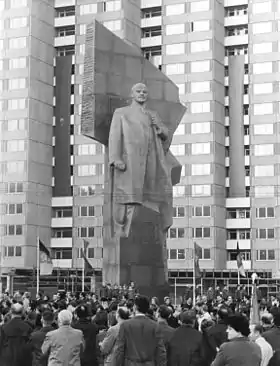Nikolai Tomsky
Nikolai Vasilyevich Tomsky (Russian: Никола́й Васи́льевич То́мский b. 19 December [O.S. 6 December] 1900, Ramushevo, Novgorod Governorate d. 22 November 1984 - Moscow) was a much-decorated Soviet sculptor, designer of many well-known ceremonial monuments of the Socialist Realism era.

Biography
Born in the village of Staro Ramushevo in Novgorod province, into a blacksmith's family, Tomsky studied in Leningrad. In 1927, graduated from the Arts and Crafts College.
The sculptor first came to attention with his memorial to Sergey Kirov, a heroic bronze with friezes around the base, for which he won the 1941 Stalin Prize. Thereafter his career developed in an official direction; he would be eventually tasked to re-design Lenin's own sarcophagus, produce Stalin's bust at Stalin's grave, and produce at least five major statues of Lenin throughout the Soviet Union. His distinctive red-granite Lenin stood in the Leninplatz of East Berlin from 1970 to 1992.
Tomsky became a full member of the USSR Academy of Arts (1949, and president from 1968 to 1983), member of the Academy of Arts of the GDR, the Hero of Socialist Labor (1970), five Stalin Prize laureate (1941, 1947, 1949, 1950, 1952), the winner of the Lenin Prize (1972) and the USSR State Prize (1979), holder of three Orders of Lenin, the Order of the October Revolution, Order of the Red Banner and the Order of Karl Marx (GDR). He taught at MGAHIS (1948-1982), as Professor and as Rector of the Academy (1964-1970).
Work
- monument to Sergey Kirov, Kirovskaya Square, St. Peterburg, 1937, with architect Noi Trotsky
- major frieze called Defense, Labor and Rest at the House of Soviets, St. Petersburg, 1936-1941, for architect Noi Trotsky
- Lenin, Varshavsky Rail Terminal, St. Petersburg, 1947, removed 2001
- bas-reliefs at the Novokuznetskaya Moscow metro station, 1943
- Victory Bridge, Moscow, with architect Dmitry Chechulin, 1943
- Stalin at the Kurskaya (Koltsevaya Line) Moscow metro station, 1950, removed 1961
- monument to Ivan Chernyakhovsky, Vilnius, 1950, relocated to Voronezh in 1993
- monument to Nikolai Gogol on Gogolevsky Boulevard, Moscow (replacing the controversial monument by sculptor Nikolay Andreyev), 1952
- bust of Stalin at his grave, Kremlin Wall Necropolis, 1953
- monument to Mikhail Lomonosov, Moscow University, 1954[1]
- monument to Pavel Nakhimov, Sevastopol, 1959
- work at the Tomb of the Unknown Soldier (Moscow), 1967
- Lenin at Leninplatz, former East Berlin, 1970, removed and buried in 1992
- re-designed sarcophagus at Lenin's Tomb, Moscow, 1973
- equestrian statue of Field Marshal Kutuzov in the Kutuzovsky Prospekt, Moscow, 1973
References
- "Monument to M.V. Lomonosov". Retrieved 18 August 2016.
| Wikimedia Commons has media related to Nikolai Tomski. |